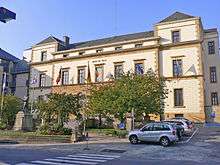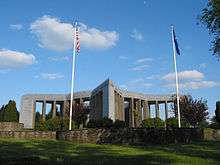Luxembourg (Belgium)
The province of Luxembourg is the southernmost and largest province in the Wallonia region of Belgium. It is bordered to the east by the Grand Duchy of Luxembourg, and to the southwest by France. It is divided between the Belgian Ardennes to the north and Gaume (the Belgian part of Lorraine) to the south. It has around 280,000 inhabitants and is the least populated of all Belgian provinces.

Cities
- 🌍 Arlon — administration center for the province
- 🌍 Barvaux-sur-Ourthe — it is actually a good centre in its own right for beginners' canoeing on the river Ourthe
- 🌍 Bastogne — centre of the Battle of the bulge
- 🌍 Bouillon — hometown of the famous crusader, and home to a well-preserved castle
- 🌍 Durbuy — claims to be the world's smallest village; some love it and others consider it a quitessential tourist trap but anyone can enjoy the walk there from nearby Barvaux
- 🌍 Florenville — the beautiful trappist Orval abbey
- 🌍 Torgny — southernmost village in Belgium, and dubbed most beautiful village of Wallonia
Other destinations
- Ardennes; the most sparsely populated region in the Benelux, this is a hilly countryside region covered with forests. It makes a great place for hiking and cycling. It is a popular tourist destination, especially for Dutch and Flemish people. It occupies the northern two-thirds of the province.
Understand
The province of Luxembourg was once part of the same body as the Grand Duchy of Luxembourg. When Belgium was created, both Luxembourgs were part of the newly born country, but after Dutch demands, the culturally German part of the region (Grand Duchy) was split from Belgium, while the Romance-speaking (the province) stayed within the country.
Talk
French is the language spoken everywhere since its imposition in school. Nevertheless, a number of traditional languages are still spoken or understood by part of the population, especially in most rural areas:
- The Ardennes version of Walloon, in the Ardennes
- Gaumais in the south
- Luxemburgish, considered by some as a German dialect, by others a Germanic language, with several French loan words, near the border
Dutch is spoken in most tourist places in the north of the province, because of large numbers of Dutch speaking visitors during the summer. But even though most Belgians will have learned Dutch at school, you'll be better off with English in areas less used to tourists. Most young people will have at least basic understanding of English, and you should be able to sort out most things with it. German is spoken by some, especially near the Luxemburgish border.
Get in
By car
The province is served mainly by two motorways, that meet near Neufchateau, in the center:
- The E411 that links Brussels to Luxembourg
- The E25 that links Liège to Neufchateau
Most of the province is within 1-2 hours rides from Brussels and 40-90 minutes from Liège. Arlon is 20 minutes from Luxembourg.
By train
The Brussels-Luxembourg line has four main stops in the province:
- Marloie (1h40 from Brussels, 40' from Namur)
- Libramont (2h, 1h)
- Marbehan (2h20, 1h20)
- Arlon (2h40, 1h40)
Trains leave both ways every hour from 6:00 to 22:00.
Get around
By car
The province is well served by a network of paved roads. Those suffer from the relatively harsher climate of the province, and can be snowy during winter and present potholes at all times.
By train
A number of local lines provide good service for some destination within the province:
- Libramont-Bertrix
- Arlon-Virton-Florenville-Bertrix
- Marloie-Liège
Bicycle
Some cycling paths exist, but are often badly maintained making the road a safer choice. However, the province is full of small beautiful roads that are not much used by cars and are in good state. Be careful however that countryside is more hilly than in the rest of the country, and you can find yourself in front of short but steep and frequent slopes.
Walk
Forests make a wonderful place to walk. A large number of path cross them, and most municipalities have traced some paths, with signs and possibly maps at the local tourism office. A number of long-distance paths also cross the province, such as the Transardennaise, and GR15.
By bus
Tec, the regional public transportation service provides a good network between towns and villages of the province, and one should find it possible to reach even the most remote village with public transportations, even though buses might be sparse on some lines (typically schools schedule to bring students to high school). Info can be found .
See

- Tombeau du Géant or Giant's Grave is one typical and scenic bend of the river Semois, surrounded by steep hills. Near Bouillon
- Memorial of the Battle of the Bulge in Bastogne. There is also a museum on the military base ("caserne") about 6 blocks from the Place de St. Pierre on the main street. This museum contains the room in which General McAuliffe issued the famous "Nuts!" reply to the German demand for surrender in 1944. There is also much equipment, small arms, and some tanks. Knock at the gate of the military base and ask to see it. On the Place de St. Pierre is a museum presentation called "I was 20 years old in Bastogne." It is an excellent description of the 1944-1945 battle focused on the civilian perspective. Three stories of dioramas, artifacts, movies, small arms, and German and American military sidecar motorcycles.
- Medieval castle in Bouillon
- Fourneau Saint-Michel shows a reconstitution of a traditional village, and a museum about the Mining past of the region. Near Saint-Hubert
Do
- Kayak on the Semois or the Ourthe. From Chiny downward on the Semois, and on the last part of the Ourthe, you should find kayak rental in plenty, provided that the water level enables you to enjoy a ride.
- Walk in the countryside, Ardennes valley and provinces have many beautiful corners to be discovered by feet
Eat
As in the rest of Belgium, quality of food in the province of Luxembourg is very good. However, fast foods and foreign food is popular, and it might be difficult sometimes to find a real local specialist.
Drink
Belgium is the country of Beer, and the province of Luxembourg doesn't escape the rule, with several small breweries scattered around. Among them we can discover the Rulles, the Chouffe,... Some locals distillate their own liquor from fruits (plum, apple...), but those are not readily available, and your only chance to taste it is to be invited by one of them. In Arlon, a local white vine, the Maitrank, aromatised with woodruff is very popular, and is celebrated every year in a festival, the Fêtes du Maitrank.
Stay safe
The province, as the rest of Belgium is a very safe place. However, some fights might occur at the end of villages 'bals' where heavy drinking is involved. However, those happen usually between local youngsters, and basic precaution will avoid any trouble, and you will find your stay a very peaceful experience.
Go next
- Luxembourg is only 20 minutes from Arlon, and is an enjoyable city, with old walls
- Avioth, in France, demonstrate a spectacular Basilica in the tiny village, and Montmédy has an old Vauban Fortress